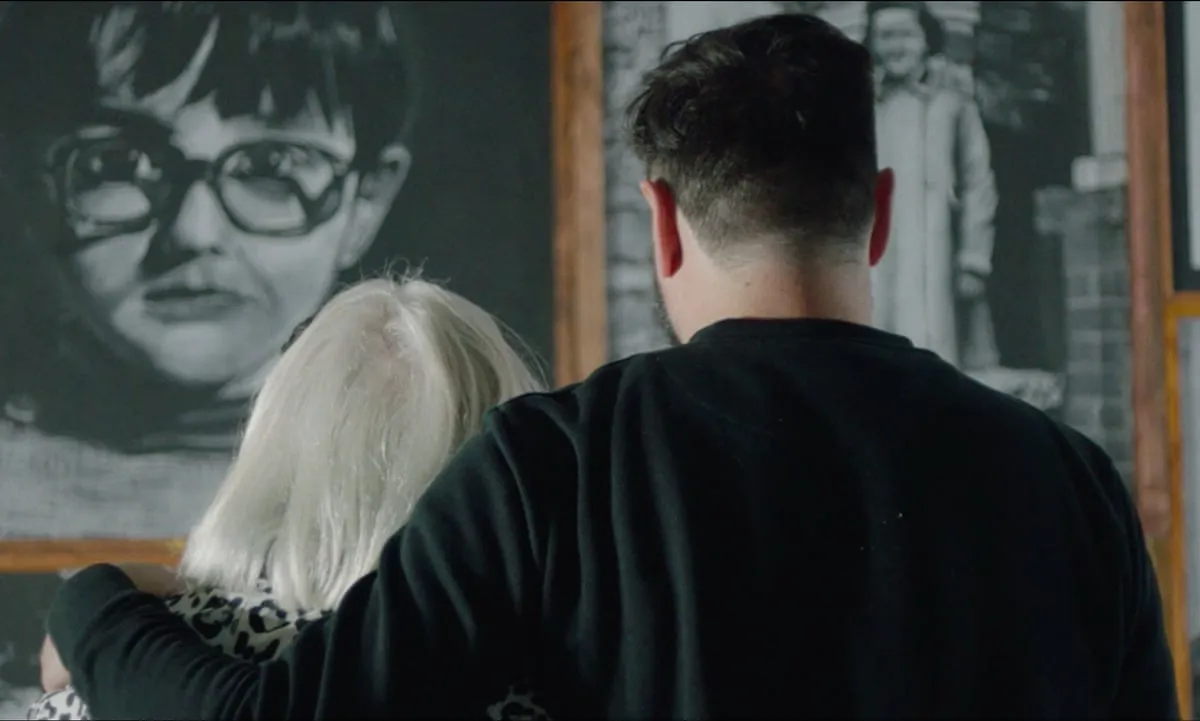As a street artist in Dublin, going by the name Asbestos, he saw his own mother Helena’s steady decline into Alzheimer’s disease. Wanting to understand her experience and process his own emotions, he teamed up with director Ross Killeen to create the deeply moving documentary Don’t Forget to Remember.
Their film provides intimate access into one family’s daily challenges while bringing experimental art into a thought-provoking discussion on memory and identity.
Helena’s diagnosis arrived years ago, and her condition has progressed to the point that routine tasks cause difficulty. Simple questions from her devoted husband Matthew, like clues in their daily crossword, often meet with blank confusion rather than recollection.
Asbestos observes these upsetting scenes and channels his mother’s struggle into his public chalkboard drawings, reimagining family photos. By exposing the works to natural deterioration, they showcase how Alzheimer’s erodes someone grain by grain.
Through its unflinching yet empathetic portrait, Don’t Forget to Remember brings awareness to a condition that hits close to home for many. With artistic creativity and human compassion, Asbestos and Killeen have crafted a special film exploring how we cope with unavoidable change and celebrate what we’re able to share, even if just for a moment. Their documentary deserves wide attention for initiating important conversations around a challenging topic.
A Family’s Struggle
We learn that Helena received her Alzheimer’s diagnosis years ago, and her family has watched her steadily lose pieces of herself since. As her concerned husband Matthew, she relies on him completely for her daily care. Once lively and social, Helena now struggles to remember even basic facts like the day or month.
Her son Asbestos sees these upsetting effects of the disease firsthand. A street artist in Dublin, he channels the family’s experience through experimental works. Scenes show Helana’s gentle confusion as Matthew attempts to spark fading memories through activities like their puzzle. We also see archive footage and Helana’s past blended with Asbestos’ surreal visualizations of her slipping away.
Rather than sensationalize the difficulties, Ross Killeen’s documentary intimately portrays the humanity of Helena’s family as they tenderly support her. Asbestos’ art reveals his emotional process alongside theirs. This unconventional structure juxtaposes realities in a thought-provoking manner. It brings viewers into the family’s world in an empathetic light, highlighting their resilience against a challenge many face.
Through its compassionate lens, we come to know these characters in all their vulnerability, complexity, and love. Their story communicates a message many could gain solace in—that even when memory fades, human connection retains profound strength.
Art to Understand Loss
Facing his mother’s steady memory declines, Asbestos turned to creative expression to make sense of her experience and his own feelings. One striking project saw him depict family photos on large outdoor blackboards through his distinctive style. But he didn’t stop there—the works were left to naturally fade at the hands of weather, time, and public intervention.
This “Don’t Forget to Remember” exhibition powerfully mirrored the impermanence of memory loss. As rain blurred the images or additions appeared, it symbolized snippets of Helena’s past washing away. Allowing the public to collaborate continued the metaphor—memories transform and take new shape, dependent on individual perspectives.
We see Asbestos’ street art similarly reflects transience. Scenes reveal his evocative visualizations covering Dublin’s streets and buildings. But like memories, his creations never stay as vibrant or defined as when first envisioned. Their ephemeral nature parallels the fleetingness of both remembrance and human life.
Throughout the film, returning to art clearly aids Asbestos in processing the family’s situation. Whether reimagining old photos or adding new works, his creative outlet anchors moments of clarity amidst distress. The documentary indicates that while Alzheimer’s steals away identity, imaginative expression can offer connection even when direct communication falters.
For Asbestos, harnessing different artistic avenues to cope with loss and understand his mother’s plight proved an intimate act of care, respect, and hope.
Memories in Focus
Old home movies and photographs serve to both jostle what remains of Helena’s recollections but also highlight what’s been lost. Scenes show her husband attempting conversation with these anchors from the past, hoping a glimpse might spark new connections for Helena.
We see the family’s routine daily crossword holds similar purpose. Realizing Helena can no longer provide the answers herself, it emphasizes Alzheimer’s cruel method of steadily diminishing even basic memory function. Their interactions emphasize preserving close bonds wherever possible.
Filmed in a simple black and white palette, “Don’t Forget to Remember” reinforces memories’ elusive nature through its stark visuals. Shots blend Helena’s previous eras seamlessly into her current reality, a poignant reminder of how a lifetime collects to form human identity.
The contrast between vibrant clips of celebrations past and jarring moments of blank confusion drives home the relentless progress of the disease. Yet despite losses, moments like Helena laughing at pictures of Asbestos uplift, signaling what perseveres in her spirit.
By exploring memory from so many angles, the documentary highlights its complex roots in our social connections and personal narratives. Even as Alzheimer’s dismantles a mind, the film suggests caring relationships preserve the essence of its subject. Though a sad fate, “Don’t Forget to Remember” conveys life’s beauty remains within a community that remembers together.
A Caregiver’s Compassion
Each day, Matthew embraces the immense responsibility of caring for his wife full-time. Scenes revealing their routine emphasize Alzheimer’s crushing demands. Once lively in conversation, Helena now depends on him even for minor interactions.
We see how the disease systematically dismantles social abilities—Helena struggles with easy discussions and seems distressed when unable to recall relatives’ names. Alzheimer’s cruelly strips away pieces of what makes us human.
Especially heartbreaking are moments where archival pictures or home videos trigger fleeting glimpses of recognition, only to fade back into confusion. Family bonds that seemed unbreakable fray as memory fades, leaving profound emotional impacts.
Amidst these challenges, Matthew remarkably retains steadfast patience and affection. Never treating Helena as a burden, he meets each setback with compassion. His dedication reflects resilience in the face of loss and reminds us that unconditional care persists where medical cures cannot.
This intimate view of a caregiver’s daily struggle movingly depicts how Alzheimer’s effects radiate far beyond its victims. But it finds hope in humanity’s power to overcome even profound difficulties through empathy and affirm dignity in those we love until the end.
Alzheimer’s Illuminated
Don’t Forget to Remember clearly resonated—it won awards, including the Audience Prize at the Dublin Film Festival.
At its heart, the documentary explores profound questions of what makes us who we are. As Helena’s steady loss of memory dismantles her sense of identity, her loved ones rally in devotion. Their story shares moving insight into how Alzheimer’s affects not just individuals but also their family units.
By gaining such intimate access into one household’s challenges, it communicates their daily experience with a rare level of empathy. Lighting up both the emotional devastation and inspirational resilience, the film informed perspectives on a condition affecting millions globally.
Most powerfully, the documentary sparked meaningful discussions where cures don’t yet exist. Asbestos’ artistic outlet to process grief guided thoughtful conversation around memory and its fragility. Funded for that purpose, it fulfilled an art-meets-social impact role beautifully and with grace.
Don’t Forget to Remember leaves its closing message: even when recollections fade, we retain human connections capable of cultivating understanding, compassion, and hope. Its achievements will echo for supportive audiences and Alzheimer’s communities alike.
A Story that Resonates
Throughout this film, the audience bears empathetic witness to one family’s experience living with Alzheimer’s. We see not through sensation but intimacy—the unvarnished struggles and small moments of light that sustain them.
By exploring memory, identity, and caregiving from angles both heartbreaking and hopeful, the documentary meaningfully illuminated this condition’s profound impacts. While no answers emerged, meaningful discussions did.
Most importantly, Don’t Forget to Remember reminds us that even when a disease steals away what we know, human connections can retain purpose and dignity through compassion. Asbestos’s artistic journey to understand his mother models how creativity may aid such difficult passages.
Though unflinchingly depicting loss, the film ultimately pulses with life. It leaves on an optimistic note of appreciation—for those we love, for artists enabling crucial conversations, and for life’s beauty intrinsically tied to togetherness, wherever found. Memory may fade, but the community remembers.
This story deserves appreciation not only for its revelations but also for reassurances. Some will find solace in its themes of familial devotion, resilient spirit, and hope wherever one sees a reflection of our shared humanity.
The Review
Don't Forget to Remember
With great empathy and care, Don't Forget to Remember brings an important story to light through the intimate lens of one family's experience. While undoubtedly difficult at times, Asbestos and Killeen's documentary balanced difficult realities with moments of light and reminders of life's persistence. Their film sparked crucial discussions through meaningful portraits of memory, identity, and love against adversity.
PROS
- Intimate and authentic portrayal of an Alzheimer's family
- Thoughtful examination of memory, identity, and their fragility
- Asbestos's artwork provided moving metaphor and emotional outlet.
- Uplifting message about human compassion and creativity's power to heal
CONS
- Very emotionally heavy at times, may be difficult for some viewers.
- Limited background on filmmakers and production processes





















































